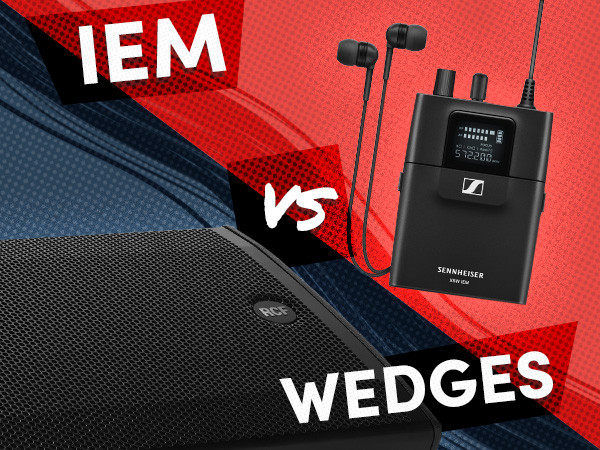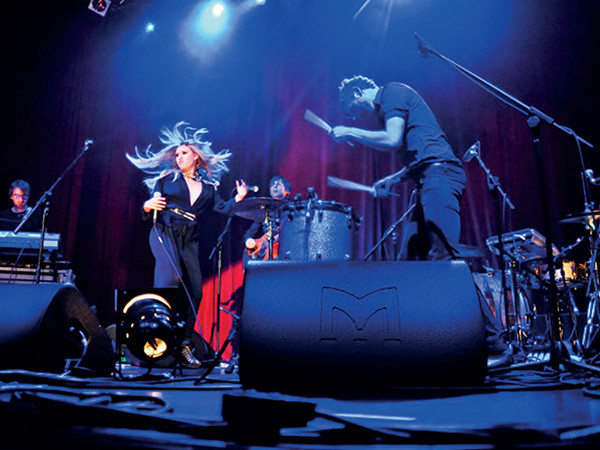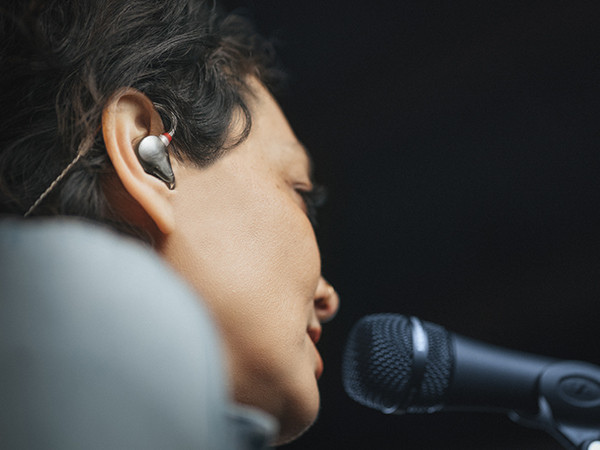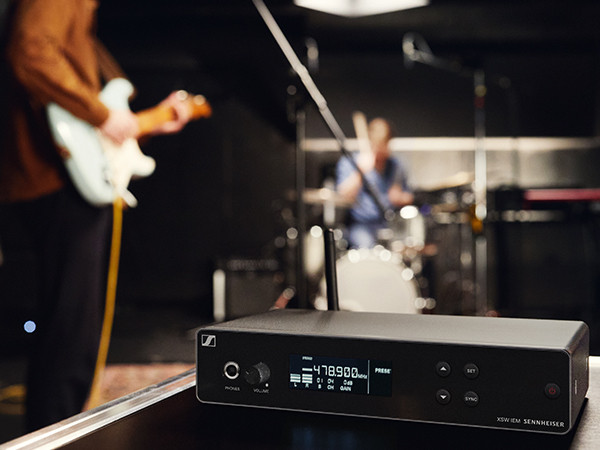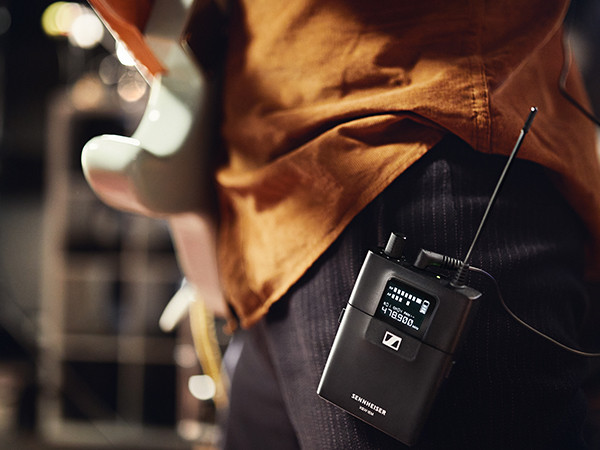IEMs vs Wedges, Which one's for you?
Posted on: 19th August 2022
Traditionally stage monitors are speakers placed on the stage and directed toward performers, these are known as wedges and have been around since the 60’s. IEMs (In-ear monitors) are devices that allow performers to have the sound sent wirelessly to their headphones. These have been around for a long time too but have been growing in popularity as technology has improved. Both have their benefits and musicians have their preferences, but which is better?
1. Sound Quality
When it comes to sound, consistency is key. With wedges, it’s impossible to have the mix sound exactly the same at every venue, with each space having a different room layout and acoustics. With IEMs you don’t need to worry about how the environment will play a role in the sound quality because the sound is going directly into your ear.
Wedges output a frequency of around 50Hz to 20,000Hz. IEMs can reach as high as 40,000Hz meaning you’ll be able to hear the mix in much greater detail.
Another thing to note is that wedges cannot produce full transient details. Put simply, transients are the short bursts you hear at the beginning of a sound, this could be things like the pick attack on a guitar, the crack of the stick on a drumhead and the consonants in your vocals. Transients can be quite harsh but with the right compression and processing can deliver a more dynamic performance. IEMs are able to give a more realistic transient response giving users the ability to hear these transient sounds in more detail.
2. Mobility
Wedge monitors generally have a ‘sweet spot’ where the sound is at its best, so the output will differ depending on where you are on the stage. This should be fine for static performances, but if you move out of this sweet spot you might not be able to hear the mix accurately, making the performance sound inconsistent. IEMs don’t have this problem because the sound is going straight into your headphones and aren’t limited to just a sweet spot. This is something that will greatly benefit a performer that’s constantly on the move or wishes to engage with the audience.
3. Portability
Compared to wedges, IEM systems can be very compact. At their most basic, IEM systems are just a transmitter, bodypack and headphones. Though for larger spaces you may require antennae or a signal booster. This would still be less hassle to transport than bulky wedges and cables.
In addition to transport, setup is also something to consider. Setting up wedges, trying to get perfect dispersion and creating that ‘sweet spot’ can take time when compared to a simple IEM system. IEMs also make for a cleaner setup. Lots of wedges and cables front and centre of a performance can make it look messy; especially in an environment that requires a more professional or aesthetic look such as a wedding or corporate event.
4. Cost
The biggest trade-off for the precision and versatility of IEM systems could well be the cost difference. A professional IEM will likely set you back £100’s. While there are plenty of cheaper systems out there, these are often far less reliable and lack the essential features of pro-level systems, and will probably leave you disappointed. IEMs can also only be used by one person at a time; throw in more receivers for each performer, additional transmitters for individual mixes and aerial infrastructure for increased range and the costs soon build.
Monitor speakers are generally much cheaper, meaning you can provide each performer with their own speaker and individual mix at a much lower cost. While you may have to invest in power amplifiers to run your speakers, you do also have to choice of active speakers to reduce costs and kit.
5. Reduced Vocal Strain
If a wedge monitor is set to a louder setting, a singer might not be able to hear themselves, making the singer put more stress on their voice so they’re able to hear themselves. This may cause vocal strain on the singer and could potentially damage their vocal cords. With an IEM monitor, because the mix is personal to the user, you can lower the volume so you won’t have to raise your voice in order to hear it.
6. Hearing Health
Venues can be very noisy environments; wedges aren’t the only sound to think about on a stage. There’s sound coming from the percussions, speakers, amplifiers and the audience; even with ear protection this can cause issues such as tinnitus and harm to your ears. IEMs offer both direct sound to you as well as some form of protection from the other sounds so you can have the volume at a low level and be protected from potential hearing damage.
In-ears with noise cancelling capabilities can block out harsh frequencies that can harm your hearing. However, this comes at the cost of hearing the ambient sound of the space which could create a disconnect with the audience. An in-ear with slightly lower noise cancelling properties could reduce this problem but you still won’t be able to get the full impact of the audience like you would with a wedge system.
7. IEMs Eliminate Audio Bleed (Clean Audience Mix)
Audio bleed is the leakage of one audio source’s output into another; an example of this could be the drum sound bleeding into a guitar amp mic or the output of a wedge leaking into a singer’s mic. IEMs don’t have to worry about audio bleed because the sound’s going directly to the person's ear and can’t leak into the singer’s mic.
Wedges on the other hand can bleed into mics, so engineers need to take this into account and think about how to combat this. Bleed could be limited by using cardioid or supercardioid mics to reject these signals coming from other directions.
8. Personal Audio Control
Unlike wedges, IEMs are personal to each person on stage, each individual will have their own pair of headphones and own body pack. This allows each person to have complete control over the sound transmitting to them. If the vocalist wishes to have their audio turned down, they are able to do so without interfering with say the guitarist who might want to have their audio turned up. With stage monitors, individual performers might be able to hear mixes from other monitors which can be distracting.
In addition to the difference in sound levels, IEMs also allow each stage member to have a different track played to them. Having something like a click track could help the drummer stay on point and make sure they get the timing spot on. With wedges, although it is possible to have different speakers playing different tracks, if they are too close the sound might become muddy and inaudible.
9. Eliminates Feedback
Feedback occurs when a noise gets caught in a cycle that loops through the sound system. An example of this could be the singer’s vocals getting picked up by the mic, played through the speakers, back through the mic and repeated. This loop then results in a terrible screeching noise that is very harsh for both audience and performers. Wedges are notorious for creating this issue as the sound coming from these wedges is generally pointed toward someone performing into a microphone.
As mentioned before, one way to reduce this is to use a different style of mic; but the best way to eliminate feedback from monitor speakers is to use an IEM system. IEMs make monitor feedback impossible allowing the performance to run more fluidly and put the performer's mind at ease.
10. Reliability / Usability
With wedge monitor systems, they are set up and controlled by the engineer, there is no other user input for this system. This is great because all the audio settings are controlled and monitored by a professional sound engineer. An IEM on the other hand, whilst still being set up by the engineer, is in the hands of the user. The performer might accidentally hit a button on the bodypack, play around with the settings, unplug the headphones or even knock the batteries out. Any one of these could potentially ruin the flow of the performance.
11. Interference and Reach
Monitor speakers are set up on the stage and controlled by the engineer via long cable runs. IEMs rely on wireless transmission to work, presenting issues such as interference, signal coverage, and signal strength. The engineer will need to consider things such as mics, Wi-Fi signals, mobile phones, ambient surroundings and building metalwork in order to ensure that there is a clean signal on the stage.
IEM transmitters can only transmit signals so far, so if the transmitter is located off stage, additional equipment such as aerials and antennas will be required. However, with monitors, you will still need to run a cable from the front of house to the system. So, when it comes to cables, both systems are quite alike.
12. Durability
IEMs are built for stage use, but there is only so much damage they can take. The bodypack could easily be dropped or even fall off the performer if the clip isn’t secured. Headphones are also a typical fail point, especially if they are mistreated by a non-technical user who might snag the cables or tightly wind them around the receiver. Wedge monitors however, are heavy, very durable and can’t easily be kicked or thrown around. Wedges are built for the stage and are designed to take some punishment.
Another thing to consider is that while the IEM headphones are likely to withstand the weather; the bodypacks are not IP rated and could be damaged if exposed to rain or excessive sweat. Wedges however, can have high IP ratings, making them weather resistant.
13. Stage Design
Certain performers (e.g. theatre actors) might want to keep their stage clean and clear. This is where IEMs shine because they are easily concealable and don’t stand out anywhere near as much as monitor speakers. Monitors also have cables that will need to be tidied or hidden away to avoid messing with the stage appearance, this is obviously not an issue with IEMs.
Another thing to think of is that some stage designs contain moving parts which would make it difficult to include monitors as part of the sound design.
The look of the stage is obviously down to set designers and their personal preference, but some performers might like the traditional look of having monitor speakers on stage as it gives a more legit rock and roll aesthetic.
Conclusion
As you can see there are some clear benefits to both systems. You could argue that using an IEM takes you away from the crowd and atmosphere; but if that means added safety for your hearing then it might be a worthy trade-off. IEMs also offer easy transportation, quick setups and a lot of mobility whereas wedges offer a relatively simple setup and increased robustness. At the end of the day, it comes down to your personal preference, the requirements of your performers and the type of show or space you’re specifying for. These are the questions you should ask yourself and any prospective client you are building a project for.
